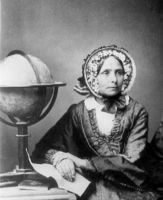Ida Pfeiffer
„She had a heart that was able to beat for the whole
world“
(Lieselotte
Stiegler)
For three years I am living between two cultures of
India and Europe with the curiosity and expectation to integrate these two
countries as a part of home inside me. For this reason I am very interested in
Ida Pfeiffer, a woman, who was travelling around the world under much more
difficult conditions than in our centuries.
Ida Pfeiffer, née Reyer, was the first
European woman who crossed the interior of Borneo.
After a problematic youth and years of marriage she
spent the third period of her life as a globetrotter and successful travel
writer – first under a male pseudonym. So she was in the age of “Biedermeier” a
noteworthy exception on her journeys. On
her trips she travelled 240000 kilometres and there were 32000 kilometres on
four continents.
She wrote many books that had been translated into
seven languages.
Travelling does not mean only local change, it means
also openness, awareness and tolerance for other cultural and social images.
In the middle of 18th century there was the
opinion that travelling is against the nature of women. Only some wealthy women
were able to travel. Franz Ludwig Posselt developed a catalogue with specific
rules for women traveller. Travelling should be only used by women for
approaching their female role. They should enlarge their experiences, therefore
they could perceive their role in
family life to be successful in society.
Ida Pfeiffer was the third child of a wealthy merchant
family in Vienna. In her childhood she read travelogues and dreamed of foreign
countries. 1820 she agreed to a marriage of convenience with the 24 years older
lawyer Mark Anton Pfeiffer from Lemburg. Then her husband got financial
difficulties. A divorce followed and Ida Pfeiffer had to educate her sons
alone. When her children were grown up she saw the possibility to live her
passion for travel and adventure. On March
22, she travelled to Palästina and Egypt and 1843 her first book came out.
She studied English and Danish, went to Norway, Sweden and Iceland. In Stockholm
she was presented to the Queen. On her first world tour she went to Rio de
Janeiro, Hongkong, Singapore, South India, Mesopotamia and Persia. 1851 she
left Vienna again and travelled to South Africa, Sumatra, Ecuador and Peru. The
aim of the next trip she started in May 1856 were Mauritius and in April 1857
Madagascar. When political disturbances broke out she was accused of espionage,
imprisoned and expelled. In February 1858 she became ill and was forced to
return to Europe. On October 28, 1858, she died in Vienna because of the
consequences of malaria.
Her records had been very interesting for ethnologists
too, because she wrote about cultural peculiarities of foreign peoples, kinds
of social and marital life. She took thousands of plants, minerals and
historical objects with her, which are presented now in the “Naturhistorisches
Museum” and in the “Museum für Völkerkunde” in Vienna.
Reading her books I asked myself, if there is any
change nowadays for travelling women? Did their impulse for research increase?
How do todays’ women transport and integrate their experience of foreign
cultures?
“Your journey is endless regarding your life on the
map of your soul.”
(Lotte Stiegler)
Author: Lieselotte Stiegler
Translation: Lieselotte Stiegler and Maria Dürr
Sources:
- http://de.wikipedia.org/wiki/Ida_Pfeiffer
- Habinger Gabriele: Eine Wiener Biedermeierdame erobert die Welt. Vlg. Promedia, Wien 1997
- http://www.cjd-braunschweig.de Hartmann Lina: Zwischen Skepsis und Toleranz; öffentliches Meinungsbild über Frauenreisen im 18. und 19. Jahrhundert, Studie, 2007
Photocredits: Ida Pfeiffer, author unknown. Source:
http://en.wikipedia.org/wiki/File:Ida_Pfeiffer.jpg , viewed on 5th November 2014.
This image (or other media file) is in the public domain because its copyright has expired.




